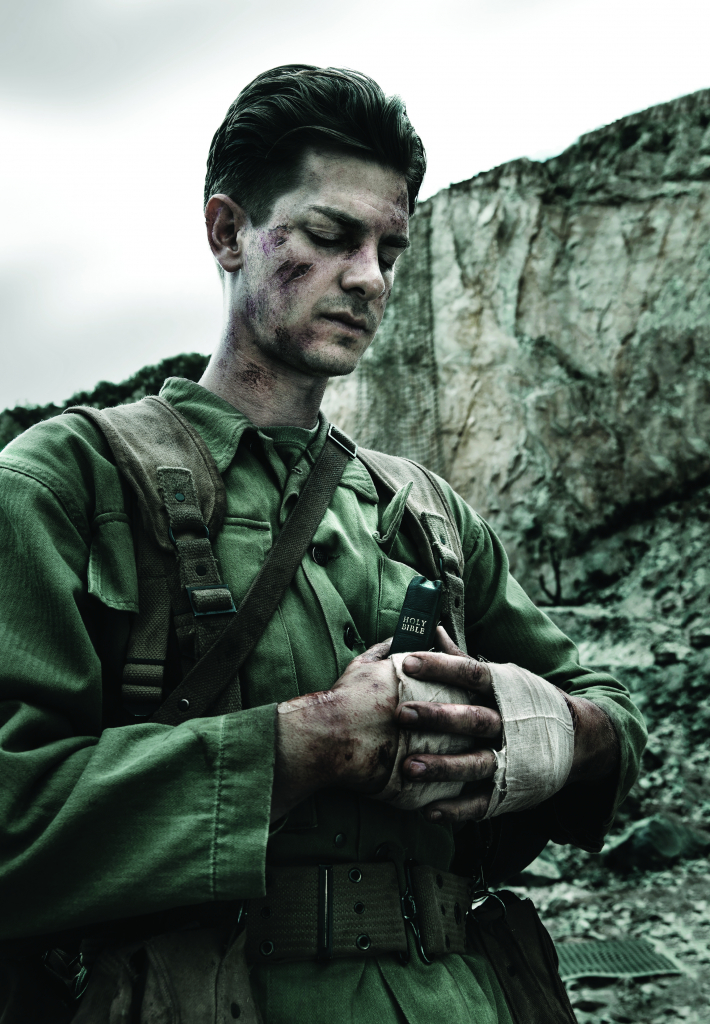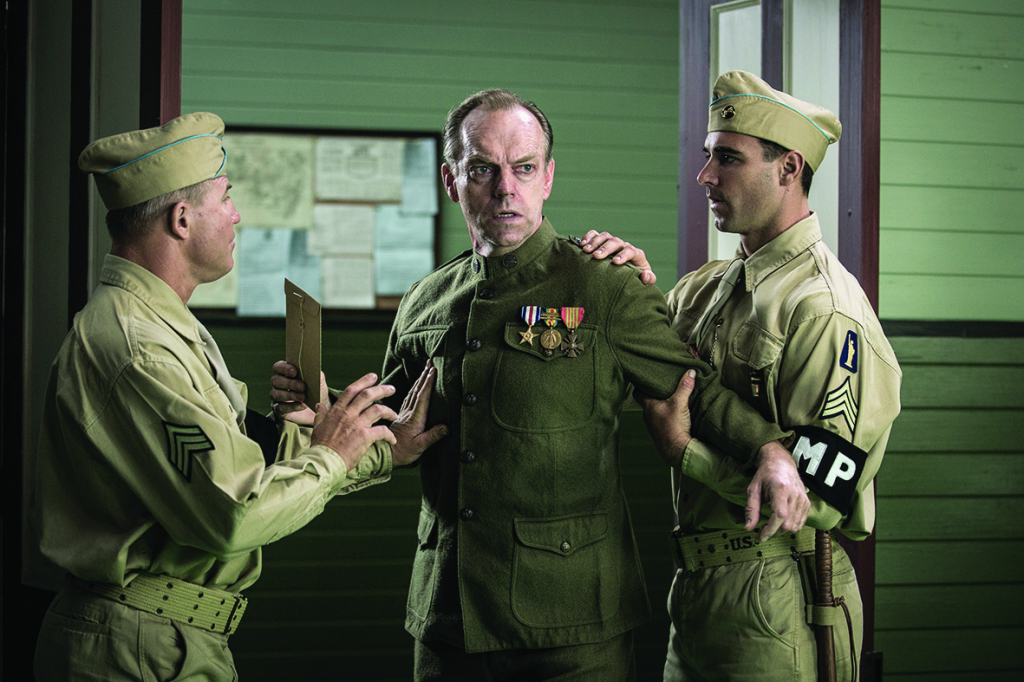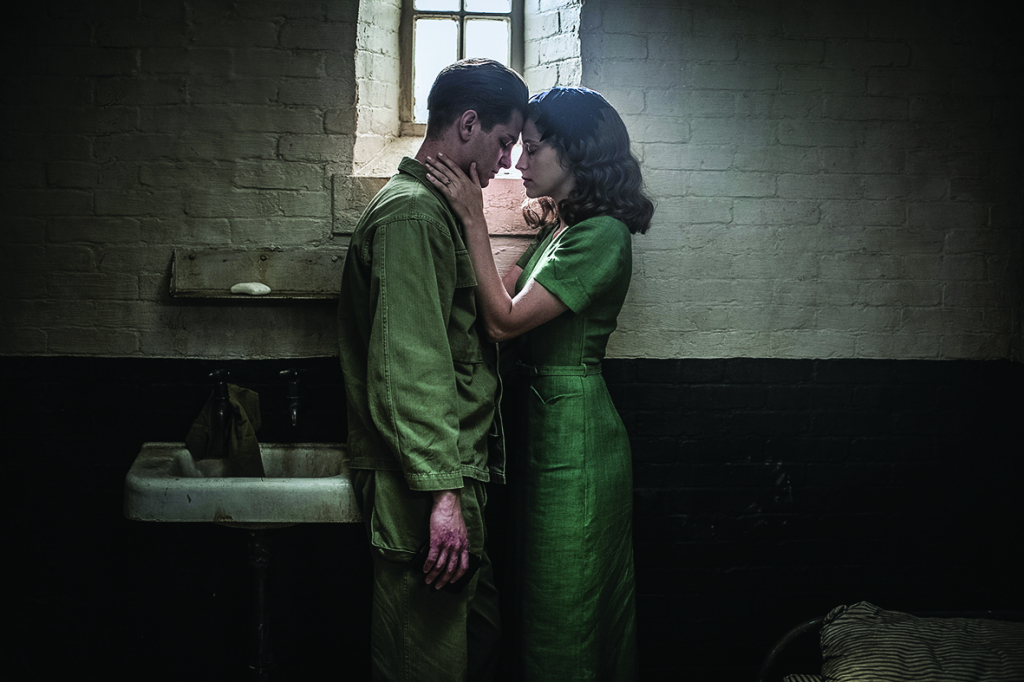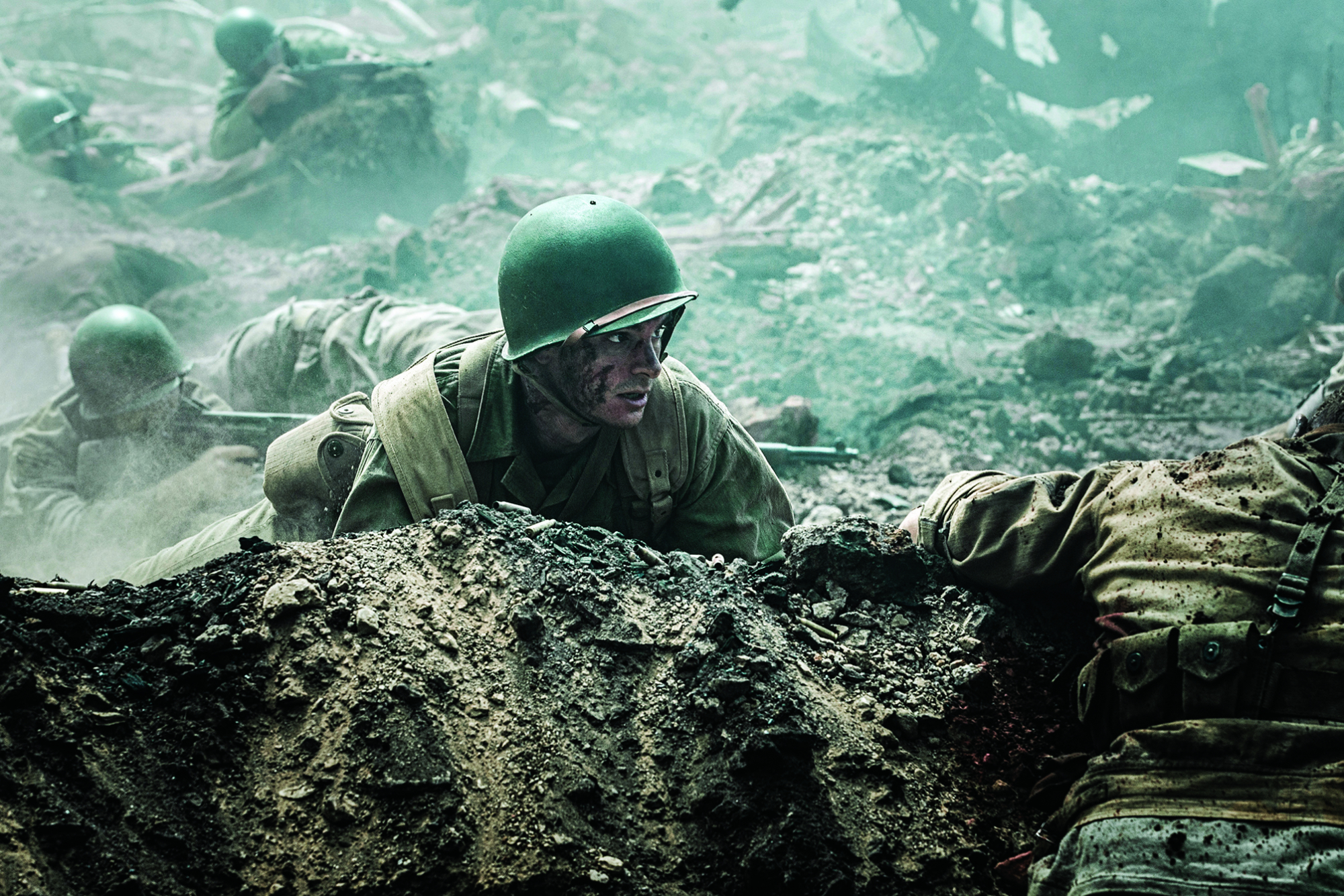Flawed as the Academy Awards are, the pool of films they pit against one another for the top prize forms an interesting microcosm, giving insights into the kinds of issues that capture mainstream attention. In any given year, the Best Picture Oscar nominees will almost always include at least one film revolving around a war. This year’s offering was Hacksaw Ridge (2016). Directed by Mel Gibson – a fact that the marketing team seemingly took pains to hide in the film’s advertising campaign[1]The poster for the film touts that it is ‘[f]rom the acclaimed director of Braveheart [1995] and The Passion of the Christ [2004]’, and commentators were quick to point out the omission of Gibson’s name; see, for example, Ben Coleman, ‘Hacksaw Ridge and the Return of Mel Gibson’, The Stranger, 2 November 2016, <http://www.thestranger.com/film/2016/11/02/24668931/hacksaw-ridge-and-the-return-of-mel-gibson>; and Christopher Lawrence, ‘Is It Time for Hollywood to Forgive Mel Gibson?’, Las Vegas Review-Journal, 3 November 2016, <https://www.reviewjournal.com/entertainment/entertainment-columns/christopher-lawrence/is-it-time-for-hollywood-to-forgive-mel-gibson/>, both accessed 25 May 2017. – it ticks off all the criteria that a work of this nature needs to fight its way to the top.
The film industry, like every other, is subject to the whims of fashion: genres go in and out of favour, as do techniques, actors and themes. War, however, is seemingly exempt. It remains an evergreen topic for screen-content producers to explore. Most common are films set during World War I and World War II. While, theoretically, war films can, I posit, be divided into three categories – historical, zeitgeist and sci-fi dystopia – the distinctions between these don’t always sit comfortably. It seems strange to hold up Ender’s Game (Gavin Hood, 2013) against Saving Private Ryan (Steven Spielberg, 1998) and consider them subgenre buddies – so science fiction and futuristic conflicts end up peeling off into their own realm. We are then left with a line dividing the remaining films – and for every Zero Dark Thirty (Kathryn Bigelow, 2012), there is a Pearl Harbor (Michael Bay, 2001) or two, if not more. Audiences seem to only have so much tolerance for commentary on current events; they’re hearing about it on the news. That cuts into how much they’re willing to see it on the big screen, too.

What makes war such a fertile ground for storytellers is the perfect storm of politics, tragedy and truth. Life-and-death situations push human beings to their limits, inevitably bringing out the best in some and the worst in others. It’s a rich vein – screenwriters have the opportunity to launch from historical events and weave in made-up characters to explore an idea, or else can draw on one of the many strange but true tales of individuals caught up in conflict. And, significantly, historical war films allow viewers to engage with complex issues with the comfortable buffer of time.
Despite mankind’s long and storied past of bad blood and battles, it isn’t surprising that so many filmmakers have focused their lenses on what is, actually, a relatively short period of time. Though there are the occasional deviations into the Vietnam War, the American Civil War and, from time to time, a medieval battle, the spotlight remains very strongly on the two world wars. At least the latter of the two remains in living memory, and the majority of cinema-goers will have some kind of personal connection to either or both of these significant events. Then there’s the sheer scope of both conflicts: the large number of individuals involved – casualties are estimated in the tens of millions – means there are a plethora of true stories to be told.
Hacksaw Ridge tells the true story of Desmond Doss (Andrew Garfield), a soldier who enlists for service in World War II but refuses to even so much as touch a weapon. A Seventh-day Adventist, Doss staunchly believes in the commandment ‘Thou shalt not kill’. In the film, his father, Tom (Hugo Weaving), is shown to be a man broken by his own experiences on the frontline; audiences are introduced to him via a shot of him drinking in a cemetery. He is grubby, dishevelled and drunk, surrounded by the graves of friends who never came back from the First World War. Tom is anti-war but has violent tendencies, strongly implied to be a result of undiagnosed post-traumatic stress disorder (PTSD). His flaws are what push his son to become his opposite – pro-war but anti-violence. The contradictions that exist within Doss and his father, and the contrast between the two men, are an almost-perfect distillation of the question that lies at the heart of every film in this subgenre: is war honourable or abhorrent?
The contradictions that exist within Doss and his father, and the contrast between the two men, are an almost-perfect distillation of the question that lies at the heart of every film in this subgenre: is war honourable or abhorrent?
Doss is punished repeatedly for his controversial pacifist stance. At training, when his unit discovers that he is unwilling to bear arms, they take this both as a judgement of them and as an indicator that he will be a liability on the battleground. He is beaten repeatedly and the army tries to make him leave, but his conviction that the war is right and that he needs to do his part makes him stay. Eventually, he is court-martialled – and it’s only after Tom puts aside his own views and comes in to bat for his son that Doss is saved. Doss is then allowed to train as a medic, accompanying his unit to the Battle of Okinawa.
The film explores the themes of bravery, patriotism and conviction in your own moral code. In an unsurprising ‘twist’, Doss turns out to be the least cowardly of the lot. We see a muscular soldier nicknamed ‘Hollywood’ (Luke Pegler) due to his vanity and good looks completely lose his nerve during the fighting, while Doss, despite not being armed, weaves in and out of the battle, administering medicine and pulling injured soldiers to safety. He earns the grudging respect of his unit, and cements his legacy when, following the army’s retreat, he stays atop the titular ridge to rescue wounded soldiers who have been left behind. Around the middle of the film, when Doss is first experiencing pushback from the army due to his beliefs, people ask him why he is there at all. We’re never really given a satisfactory answer. We know that he believes in the war – he chooses to enlist against the wishes of his family and his then-fiancée, Dorothy (Teresa Palmer) – and we know his religious beliefs mean that he views all life as sacred. But, even though he himself never wields a weapon, his actions are indirectly responsible for taking lives as well: he saves soldiers so that they can go on killing.
There is no doubt that Doss, both in Hacksaw Ridge and in real life, is a hero. He personally saved seventy-five lives by pulling soldiers from the ridge and lowering them down to safety.[2]Dendy Icon, Hacksaw Ridge press kit, 2016, p. 3. The film even shows him giving aid to Japanese soldiers, the sanctity of life being his prime motivator. His stance, as an individual, is honourable. However, if more people on his side of the conflict took the same moral position, their war effort would have been extremely hampered. The inherent contradictions of Doss’ views are never really interrogated in the film – and, arguably, this is because it would tilt the narrative’s message too strongly one way or the other. The success of a film like Hacksaw Ridge lies in its ability to evoke emotion while remaining relatively impartial on the topic of war itself. All the audience is offered are nods to bigger issues; every point immediately has a counterpoint. War leads to large-scale loss of life, but Doss cancels this out by saving enemy soldiers. War caused Tom’s PTSD, but it also inspires him to come out of his stupor in order to protect his son.

None of this ambivalence undermines the good achieved by the real-life Doss. Hacksaw Ridge is merely an elegantly-put-together example of the brown-and-green-tinged blank slate that war films are afforded. Like Doss, they have good intentions and a foot in each moral camp. Indeed, the most high-profile and successful war-themed narratives, with rare exceptions, are the Schrödinger’s cats of cinema: they are seemingly pro- and anti-war at the same time. These films hit all the expected notes – man goes to war, man experiences tragedy, man defies odds, man’s legacy is cemented – but the takeaway message is usually one that audiences already had in mind before even watching. Viewers come to these films with their own feelings and biases about war and its ethical soundness, then have these feelings and biases ‘confirmed’ by what they choose to see on screen.
Films set predominantly in the thick of battle tend to maintain this lack of political commentary – Saving Private Ryan, Pearl Harbor, We Were Soldiers (Randall Wallace, 2002) and The Thin Red Line (Terrence Malick, 1998) pull no punches when it comes to dramatising the horrors and gore of war. Yet, equally, they highlight the honour and glory of individuals, underscoring the camaraderie formed in the crucible of conflict. Instead, it is the films that hover around the peripheries of war – those that focus on character and the world beyond the frontline – that make more solid statements. The slow-building, claustrophobic Apocalypse Now (Francis Ford Coppola, 1979) is more horror film than war epic. Similarly, The Railway Man (Jonathan Teplitzky, 2013) depicts the aftermath and reality of life for survivors, and homes in on the emotional difficulties of soldiers who must live under a prolonged shadow. Victim-centred narratives such as Schindler’s List (Steven Spielberg, 1993), The Boy in the Striped Pyjamas (Mark Herman, 2008) and The Pianist (Roman Polanski, 2002) are also unambiguous in their views on war: it is reprehensible and damages people indelibly.

In essence, the classic war film about the man sent into battle retells the same, problematically heroic story again and again. Hacksaw Ridge may stand alone as a work on its own, but, despite being a war film about a man who refuses to kill, it is also still very traditional. The formula works; this type of film continues to be nominated for awards, garner mainstream success and bring in the dollars.[3]Hacksaw Ridge had a budget of US$40 million but made US$175 million at the global box office; see Brooks Barnes, ‘Hacksaw Ridge, a Gory War Movie for Both Hawks and Doves’, The New York Times, 26 October 2016, ; and ‘Hacksaw Ridge’, Box Office Mojo, <http://www.boxofficemojo.com/movies/?id=hacksawridge.htm>, both accessed 25 May 2017. Audiences’ opinions about war may already be formed, but what the subgenre does is provide a catalyst for such opinions to be validated, for history to be remembered, and for individual stories to be highlighted. The war film endures because it allows us to interrogate human nature, behaviour under extreme circumstances, and the follies of others – subject matter that viewers will never tire of.
Endnotes
| 1 | The poster for the film touts that it is ‘[f]rom the acclaimed director of Braveheart [1995] and The Passion of the Christ [2004]’, and commentators were quick to point out the omission of Gibson’s name; see, for example, Ben Coleman, ‘Hacksaw Ridge and the Return of Mel Gibson’, The Stranger, 2 November 2016, <http://www.thestranger.com/film/2016/11/02/24668931/hacksaw-ridge-and-the-return-of-mel-gibson>; and Christopher Lawrence, ‘Is It Time for Hollywood to Forgive Mel Gibson?’, Las Vegas Review-Journal, 3 November 2016, <https://www.reviewjournal.com/entertainment/entertainment-columns/christopher-lawrence/is-it-time-for-hollywood-to-forgive-mel-gibson/>, both accessed 25 May 2017. |
|---|---|
| 2 | Dendy Icon, Hacksaw Ridge press kit, 2016, p. 3. |
| 3 | Hacksaw Ridge had a budget of US$40 million but made US$175 million at the global box office; see Brooks Barnes, ‘Hacksaw Ridge, a Gory War Movie for Both Hawks and Doves’, The New York Times, 26 October 2016, ; and ‘Hacksaw Ridge’, Box Office Mojo, <http://www.boxofficemojo.com/movies/?id=hacksawridge.htm>, both accessed 25 May 2017. |





